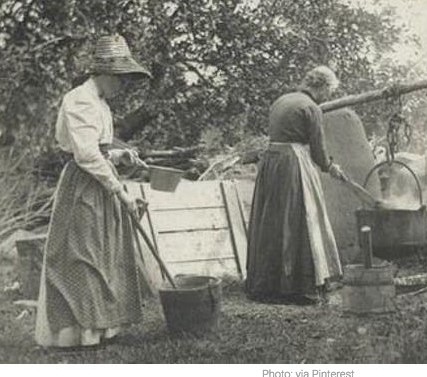Rendering Fat
Grandma’s Lye Soap was made with rendered fat; this fat would have come from goat, beef, pork or lamb.

When making soap with animal fats; the fats will need to be purified first. This is done by rendering the fat, and it’s usually done when there are cooler temperatures outside. Late fall or early winter would be the best times.
It is important to note when rendering fat for soap, not to mix the different animal fats as each has its own different SAP values.
If you want to make soap with tallow but don’t have access to fat to render down, it can be bought already rendered.
Tallow Organic Foods Grass-Fed Rendered Beef Fat Traditional Cooking Oil All Natural 100% Pure 7 LB, 1 gal, 3178 ml
Making Tallow
It’s relatively easy to render fat the biggest requirements are your fat and a large stockpot.
The first thing to do is to cut the fat up into small pieces, the smaller the better; if you have a meat grinder I would recommend grinding the fat with that. It will take a lot less time to render down when its in tiny pieces.
After doing this the fat can be put into the stock pot with water added. Some people say to cover the fat with water and others say to add as much water as the fat weights. Either way its going to render down.
After the fat and water is put into the stock pot (being careful not to fill it more than 2/3rds) add the following to each pound of fat:
- 1/8 cup salt
- 1/4 cup vinegar
- 1-2 cloves
- 3 bay laurel leaves
Adding the salt to your stock pot will draw the impurities from the fat. The rest of the ingredients will act as a deodorant; getting rid of the smell of rendering the fat and helping to create a totally odourless tallow to make soap or candles with.
Rendering down tallow can be done in the house when vinegar, cloves and laurel leaves are added while rendering. If these ingredients were not added the smell would send your outside. This is why back in grandma’s lye soap making days it was done outside on the fire.
Place the filled stockpot on the stove and heat fat and water to boiling, then simmer the mixture until the fat melts down, when it’s totally melted down remove the stockpot from the stove and take the cloves and bay laurel leaves out.
Leave the mixture to cool down enough that the fat comes to the top of the stockpot, then spoon the tallow into plastic containers and put in the fridge to harden.
Once the tallow has hardened the only other thing to do is to take it out of the containers and cut the impurities from the bottom of the tallow. Wrap the tallow in wax paper and store it in the fridge or freezer. It will be ready there for making soap and will last in the freezer for several months.
Tallow Soap Recipe
Ingredients
-
- 1200 grams tallow
- 455 grams rain water, spring water or distilled water
- 160 grams of lye (sodium hydroxide)
-
Basic Soap Making Recipe
#handmadesoap #naturalsoap #makingsoapnaturally #soapmaking #soapmaking #soaps #artisansoap #bathandbody #cpsoap #coldprocesssoap #etsy #soapbase #soapcrafter #soapmaker #soaping #soapcrafting #soaphandmade #soap #giftidea #christmas #barsoap #handmadesoap #natural #organic #skincare #coldprocess #soapsupplies #tallowsoaprecipe #tallowsoap #renderingfat
© 2018 – 2020, Tes. All rights reserved.


I have always wanted to create my own soap. I know there are many people that do it. However, do you think making soap with fats or with organic properties is better. Are their pros and cons to each? I would also like to mix in my own essential oils into bar soaps, too.
Do you happen to know any beginners guide to making soap, though? Possible some video training? I learn better by watching stuff rather than reading.
Hi Garen, Some people like to make soap rendering their own fat, of course that’s animal based so for anyone that is vegan that is not going to work. They would use plant based oils. I do have a step by step link to making soap, I’m in the process of creating a video but it’s not ready yet. If you’d like here is the link for the Make Natural Soap at Home -Step by Step instructions with pictures
Ok, thanks a lot!
I have used Dr. Bronners castile soap for years. Do you ever use it?
No I haven’t used Dr. Bronners. I usually make my own castile soap. You can make your own too. Here is a link to the recipe if you’d like to try it
Castile Soap Recipe
I have never made soap, but I actually think it would be a really fun hobby. What is your favorite thing about making soap and for what reasons do you do it? Is all soap made from animal fat? What do you recommend for vegans? (I am not but I am just curious). Where do you recommend a beginner start with all of this–what would be the cheapest and easiest way to get started? Thanks!
Hi Holly, I love making soap because I can create all different kinds of scented and colored soaps, I started making soap because of my sensitive skin and allergies. Now using animal fat would not be ideal for a vegan, in that case you would want to use plant oils – that is what I use in my recipes although I have made the odd batch from tallow.
As a beginner you could start with a simple recipe and these instructions Make Natural Soap at Home -Step by Step instructions with pictures
Soap Making Recipes
Good luck and I have to warn your, once you get started you’ll get hooked. Happy Soap making
Interesting to be taken through the process of making soap. I was only interested in buying and using. But after reading your article, I guess I will just continue buying soap until I will be able to create time for these extra curricular activity. LOL.
This article was very informative, and for the first time, I came across the word rendered fat, and what it’s used for. Great article. Thanks for sharing.
Hi Nsoh, looks like I’m going to get you hooked on soap making, I notice you have commented on some other post. Just wait til you get started lol. Glad your enjoying the site.